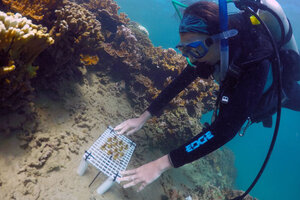Can 'super coral' save the world's reefs?
By intervening in coral evolution, biologists off the coast of Hawaii's Coconut Island have developed a bionic coral that can survive bleaching from warming seas. Time will tell if the super coral can survive in the wild.

Hawaii Institute of Marine Biology researcher Jen Davidson places a tray of enhanced coral onto a reef during a practice run for future transplants in Hawaii’s Kaneohe Bay off the island of Oahu, Oct. 23. Scientists are preparing to transplant laboratory-enhanced coral onto reefs in Hawaii in hopes that the high-performing specimens will strengthen the overall health of the reef. Using assisted evolution, researchers from the Hawaii Institute of Marine Biology are creating a form of 'super coral' that can be used to seed and strengthen other suffering reefs.
Hugh Gentry/Vulcan Inc./AP
Scientists with the Hawaii Institute of Marine Biology are conducting an experiment to grow ‘super coral,’ off of Hawaii’s 29-acre Coconut Island. Scientists are hoping ‘super-coral’ that has been gradually exposed to stressful water conditions in the laboratory will fair better in the increasingly hotter and more acidic oceans caused by global warming.
Experts with the National Oceanic and Atmospheric Administration (NOAA) said coral bleaching is killing coral reefs world wide, with Hawaii feeling some of the biggest effects.
“We may be looking at losing somewhere in the range of 10 to 20 percent of the coral reefs this year,” NOAA coral reef watch coordinator Mark Eakin said. “Hawaii is getting hit with the worst coral bleaching they have ever seen.”
Dr. Ruth Gates, the director of the Hawaii Institute, says her team's project that could save weak coral from bleaching by taking advantage of stronger individuals.
“The current state of knowledge suggests that these thriving corals and reefs have higher thresholds for environmental disturbance as a result of some combination of genetics, environmental experience and the taxonomic composition” of the algae communities living with them, says Dr. Gates.
Gates and her team's approach is known as (human)-assisted evolution. The hope is that the coral will respond to slowly introducing increasingly stressful water conditions by accelerating "rapid adaptive mechanisms in corals.”
“We’ve giving them experiences that we think are going to raise their ability to survive stress,” Gates told The Associated Press. These new corals will soon be transplanted to the bay amongst original coral, where they will hopefully grow and reproduce next summer.
“Reef coral ecological trajectories clearly indicate that the rates, the magnitudes, and the complexity of environmental change are overwhelming the intrinsic capacity of corals to adapt and survive,” writes Gates in online material explaining her work. “The goal of these activities is to develop stocks of corals with enhanced stress tolerance that can be used to build resilience…”
Tom Oliver, a marine biologist at NOAA’s Coral Reef Ecosystem Division told AP that the idea of human-assisted evolution is not groundbreaking, but Gates and her team are fighting against time.
“The question is not can they do it, it’s can they do it fast enough?” asks Dr. Oliver. “Restoration needs to have brood stock that can handle the changing conditions on reefs.”
Human-assisted evolution can not cure all global warming ills, Gates warns. Instead, humans should spend their time ending their dependence on fossil fuels and rampant greenhouse gas emissions.
About 30 percent of the world’s coral reef populations have already died from repeated bleaching.
This report contains material from the Associated Press.

